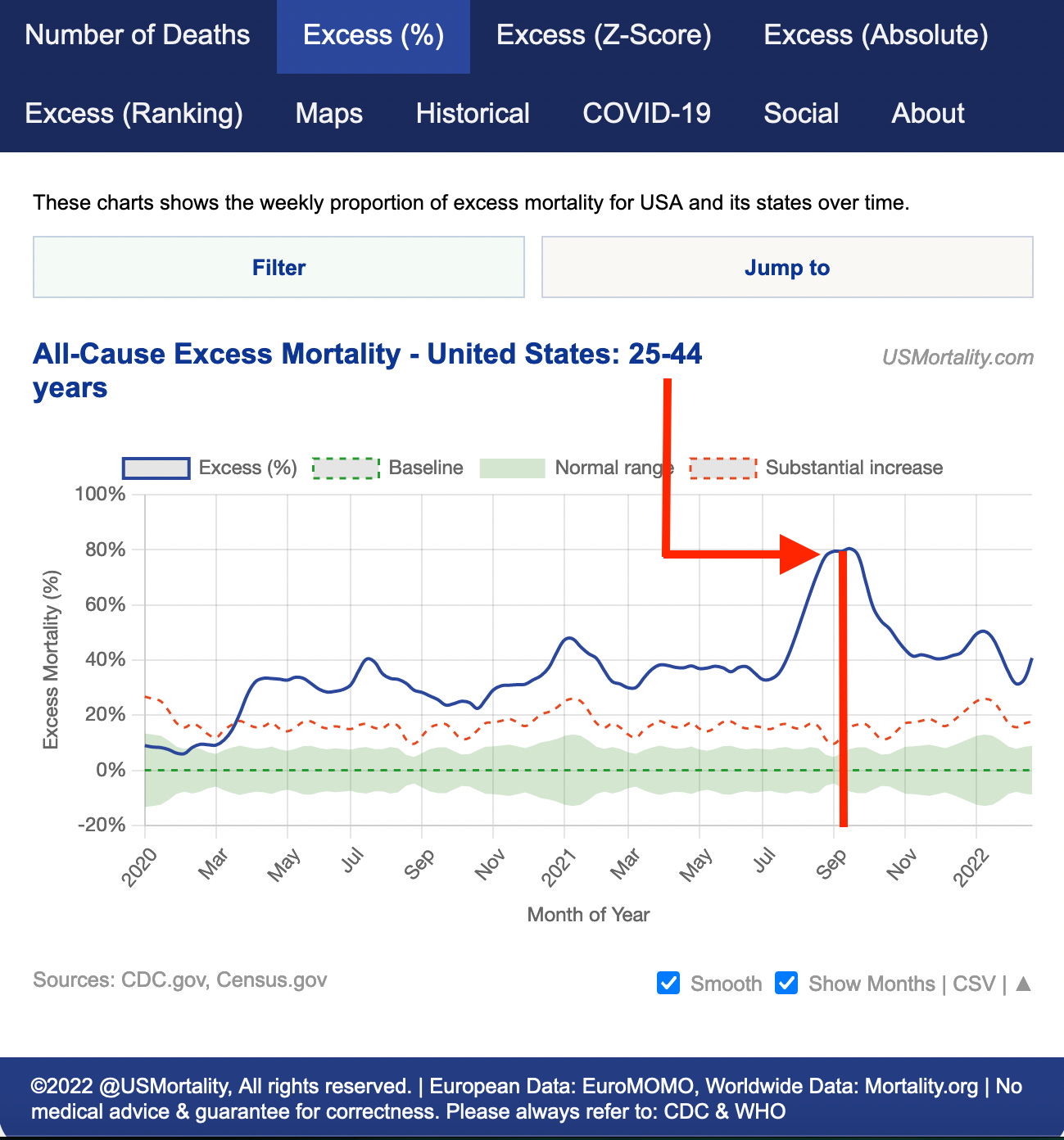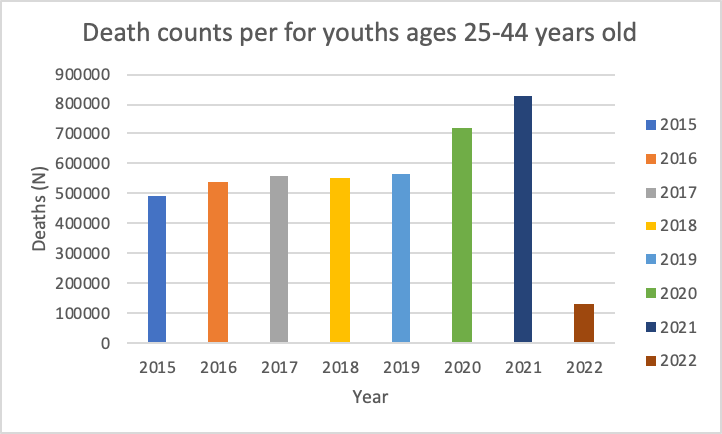Please note: you are advised to come back to this article as it will be constantly updated! And you are also most welcome to contribute! This Substack is far from complete.
As y’all are aware, I’ve been doing some looking around in VAERS at young people who have reported dying for a time now and I want to share some data and get some feedback.
On the subject of excess deaths of youths, enter Edward Dowd. He is an interesting fellow. He was a portfolio manager for the multinational investment firm BlackRock and a former analyst and Wall Street executive. We spoke at a meeting together not long ago. He has more recently spoken about the young deaths in a very specific way: in the context of the Vietnam War.
The Millennials, about ages 25 to 40, experienced an 84% increase in excess mortality in the fall, he said, describing it as the “worst-ever excess mortality, I think, in history.” It was the highest increase in excess deaths of any age group last year, seven times higher than the Silent Generation, those who are older than 85.
And the increase coincided with the vaccine mandates and the approval of the booster shots.
“Basically, Millennials experienced a Vietnam War in the second half of 2021,” Dowd said, noting 58,000 people died in the conflict.
He is not wrong. Actually, he is absolutely correct. What is happening on our doorsteps is shocking and everyone needs to pay stop genuflecting and start paying attention.
But wait! There’s more! If you head online to https://www.usmortality.com/excess-percent, prepare to have some fun. You can select ‘Filter’ and then pick the United States and a particular age group. If you select the age group from 25-44 years old you get the chart below. As you can see, this plot confirms what Edward said: there is, in fact, an 80% increase in excess mortality in this young age group in late summer/early fall 2021.
This also confirms the insurance data.
What on earth could have caused this incredible increase? Was it COVID with its Infection Fatality Rate for this age demographic of virtually 0 (“The IFR was zero among people aged 18 to 39 years”)1? Probably not. The timing is off with regard to Delta. Was it opioids? Maybe, but according to CDC, the deaths due to opioids is not sufficient to account for such an excess.2 Was it suicides? Maybe, but according to CDC, the deaths due to suicides is not sufficient to account for such an excess either.3
Was it the injections? Unknown. Can we find out using VAERS data? Maybe. We can look for hints.
Fast and dirty. My ongoing Substack diary. I love it. (I admit I have left out the analysis part of this particular article but I really just wanted to put this out there for now.)
Here’s some VAERS data. I plotted the data in VAERS reported for 25-44 year olds and extracted their death data. Of all of the Domestic deaths reported in VAERS, this age group represents 9.3% of the deaths (Total deaths: N = 12,136; Deaths individuals aged 25-44: N = 1,132). For the combined Domestic and Foreign data sets, the total number of deaths is double that of Domestic alone (Total deaths: N = 25,301; Deaths individuals aged 25-44: N = 1,828) where the 25-44 age group represents 7.2% of the deaths. The following plot includes the data for the combined data sets.
The distribution of death shows that there about twice as many reports for the ages on the elder end of the 25-44 spectrum, which is not surprising. Nothing else too shocking here. Besides dead young people reported to VAERS in the context of the magical COVID-19 injections.
I wanted to know how many deaths were reported per month so that I could compare the distribution to the overt excess in mortality reported by the CDC in late summer 2021. Below is a plot of all deaths in the combined data sets per month in 2021. (1 = January → 12 = December).
There is a peak in death reports (this is according to RECVDATE - date the entry was received to the front-end data set) in April and in August. This accounts for all deaths reported to VAERS regardless of time from injection date. Interestingly, if we only plot the death reports for this age group that were received at least 30 days following injection, we see a shift to a single ‘peak’ in late summer than appears to maintain itself.
This is interesting because it coincides with the same time that we see the excess mortality in the CDC data. This becomes clearer when we the data is superimposed. There is a peak in deaths in this age group at the same time as the peak in deaths overall for this age group as per the CDC excess mortality data.
The question remains, what is killing the millenials? The timing fits for the delayed entries and there’s also a peak in August/September for entries arising within 30 days of the injections. I am not sure if this is significant yet. Still thinking on it.
I believe that drug-related deaths and suicides are accounting for some of the deaths in this age group based on the upward trend from previous years.
Determining the percentages of deaths attributed to all of the different causes for this particular age group is tricky. It might be me and my desire for organization and order in data, but I find these 2 things are lacking in the source data.
From what I can see so far, the suicides and overdoses, even though they have been on the rise for the past 2 years, comprise only a small percentage of the deaths in this age group.4
Surprisingly, malignant neoplasms outrank all other ‘select’ death causes across all age groups and have done so for many years. I am also surprised not to see the overdoses and suicides listed in the select cause of death list as plotted below even though, percentage-wise, neither comprise even 1% of the total death count for this age group.
To be continued…
https://www.ncbi.nlm.nih.gov/labs/pmc/articles/PMC8689980/
https://www.cdc.gov/nchs/products/databriefs/db428.htm
https://www.cdc.gov/nchs/fastats/suicide.htm
https://www.cdc.gov/nchs/products/databriefs/db398.htm#fig5











Jessica- the item that stands out most to me is the etiology of Alzheimers and generic dementia as one of the four major bars in the last graph- and for the last 6 years with stable proportionality. I agree neoplasms is non intuitive, but I don't understand the dementia fraction being so large in this young age group. Parenthetically, Alzheimers is specifically defined as a 'presenile' dementia, meaning (not 70-90 year-olds) although most uninformed sources use it as a generic term for dementia, which it really is not.
- M R Weiss, MD
Increasing rates of autoimmune disease in children and young adults -> more immunomodulatory drugs and immunosuppressants prescribed as treatment -> more early cancers?